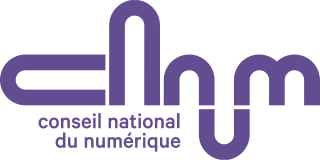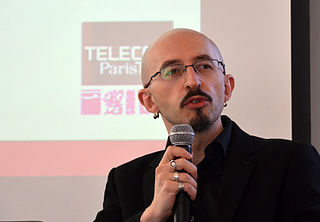Information architecture (IA) is the structural design of shared information environments; the art and science of organizing and labelling websites, intranets, online communities and software to support usability and findability; and an emerging community of practice focused on bringing principles of design, architecture and information science to the digital landscape. Typically, it involves a model or concept of information that is used and applied to activities which require explicit details of complex information systems. These activities include library systems and database development.
Electronic publishing includes the digital publication of e-books, digital magazines, and the development of digital libraries and catalogues. It also includes the editing of books, journals and magazines to be posted on a screen.
Enterprise content management (ECM) extends the concept of content management by adding a timeline for each content item and, possibly, enforcing processes for its creation, approval and distribution. Systems using ECM generally provide a secure repository for managed items, analog or digital. They also include one methods for importing content to bring manage new items, and several presentation methods to make items available for use. Although ECM content may be protected by digital rights management (DRM), it is not required. ECM is distinguished from general content management by its cognizance of the processes and procedures of the enterprise for which it is created.

The Conseil supérieur de l'audiovisuel, abbreviated CSA, was a French institution created in 1989 whose role was to regulate the various electronic media in France, such as radio and television. The creation of the Haute Autorité de la Communication Audiovisuelle was a measure founded in the Socialist Party's electoral program of 1981, called 110 Propositions for France.

Dominique Moulon is a historian of art and technology, art critic and curator, specializing in French digital art. He is the author of the books Art contemporain nouveaux médias and Art Beyond Digital.

Serge Joseph Abiteboul is a French computer scientist working in the areas of data management, database theory, and finite model theory.
Edmond Couchot was a French digital artist and art theoretician who taught at the University Paris VIII.

Opération Teddy Bear is an educational comic strip video game released in 1996. It was developed by Index+ and a co-production with Flammarion, and is written by Edouard Lussan.

Henri Verdier is a French entrepreneur and digital specialist who has been serving as the country's ambassador for digital affairs since 2018. Previousy he was the French State Chief Technology Officer (CTO) from 2015 to 2018 and, before, the Head of Etalab, the French Agency for Public Open data.

The Conseil national du numérique is a French independent advisory commission created on 29 April 2011 by the French presidential decree n°2011-476. It was reorganized and expanded by another French presidential decree on 13 December 2012, to expand its spectrum of actions to all the questions set up by the development of the digital in society and economy. The Council issues independent opinions and recommendations on any question relating to the impact of digital technologies on economy and society. The government can consult the Council on new legislation or draft regulations.
The Poietic Generator is a social-network game designed by Olivier Auber in 1986, and developed from 1987 under the label free art thanks to many contributors. The game takes place within a two-dimensional matrix in the tradition of board games and its principle is similar to both Conway's Game of Life and the surrealists' exquisite corpse.
On 6 May 2015, the European Commission, led at the time by Jean-Claude Juncker, communicated the Digital Single Market strategy which intend to remove virtual borders, boost digital connectivity, and make it easier for consumers to access cross-border online content. The Digital Single Market, which is one of the European Commission's 10 political priorities, aims to fit the EU's single market for the digital age – moving from 28 national digital markets to a single one and then to open up digital services to all citizens and strengthen business competitiveness in the digital economy. In other words, the Digital Single Market is a market characterized by ensuring the free movement of people, services and capital and allowing individuals and businesses to seamlessly access and engage in online activities irrespective of their nationality or place of residence. Fair competition conditions and a high level of protection of personal and consumer data are applied.

Webcomics in France are usually referred to as either blog BD or BD numérique. Early webcomics in the late 1990s and early 2000s primarily took on the form of personal blogs, where amateur artists told stories through their drawings. The medium rose in popularity in economic viability in the country in the late 2000s and early 2010s. The Turbomedia format, where a webcomic is presented more alike a slideshow, was popularized in France in the early 2010s.

Sylvie Merzeau was a French academic, university professor at the Paris Nanterre University and a photographer.

Béatrice Galinon-Mélénec is a French semiotician. She is professor emeritus of communication studies, specializing in the fields of anthropology of communication and the analysis of the non-verbal dimension of interpersonal communication situations. Her approach to the interpretation of signs is based on the new wave of semiotics, known as anthroposemiotics where embodied semiotics takes a central position.

Antonio A. Casilli is a Professor of Sociology at Télécom Paris, the school of telecommunications engineering of the Polytechnic Institute of Paris, and an Associate Researcher at the School for Advanced Studies in the Social Sciences. His research focuses on computer-mediated communication, labour, and fundamental rights. He has been a regular commentator at La Grande Table and Place de la Toile on France Culture.

The loi pour une République numérique is a French law first proposed by Axelle Lemaire, Secretary of State for Digital Affairs, voted on 07/10/2016.
The Total Digital Access to the League of Nations Archives Project, or LONTAD is a grant-funded large-scale digitization project to digitize, preserve, and provide online access to the archives of the League of Nations. Its fundamental aim is to modernize access to the archives for researchers, education institutions, and the general public. The project will result in 250 terabytes of data, over 500,000 units of descriptive metadata, and the rehousing, preservation and conservation of the physical archives. The project is managed by the Institutional Memory Section (IMS) of the Library of the United Nations Office at Geneva. Launched in 2017, it is scheduled for completion in 2022.
IEML is an Open source artificial method to represent the semantic content of a linguistic sign. It was designed by Pierre Lévy as an Open collaboration project as part of his works on Collective intelligence in order to encode meaning in a computer readable way. Its design is based on mathematics and logic abstractions but with a clear inspiration from the organic structure of natural languages.
The Regulatory Authority for Audiovisual and Digital Communication is the French independent administrative agency resulting from the merger on 1 January 2022 of the High Audiovisual Council (CSA) and the High Authority for the Distribution of Works and Protection of Rights on the Internet (Hadopi). ARCOM is responsible for both audiovisual and digital communications.










